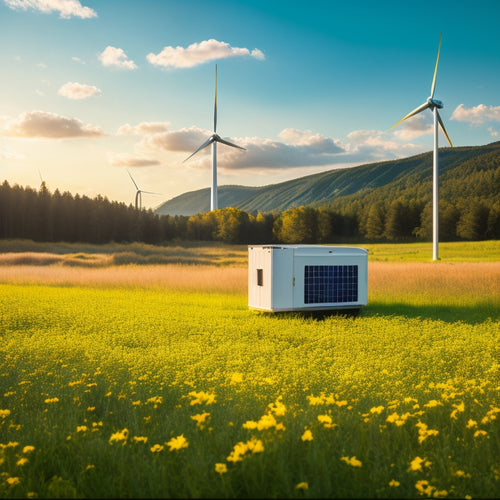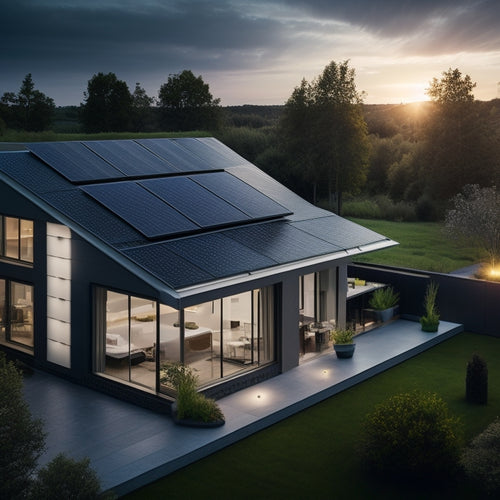
Home Solar Installation
Share
When considering home solar installation, you'll want to optimize your system for maximum energy production. To start, you can take advantage of government incentives like federal tax credits and state rebates to reduce upfront costs. Proper panel orientation and installation are essential, with south-facing panels at an angle matching your location's latitude being ideal. Assess your roof's pitch and stability to guarantee a successful installation. Finally, maximizing energy conversion rates through high-efficiency panels and energy storage solutions can lead to significant long-term savings and a reduced carbon footprint. Now, investigate how to further tailor your system to your unique needs.
The Essentials
- Home solar installation can provide a 26% federal tax credit and state rebates to reduce upfront costs.
- Proper panel orientation and installation maximize energy harvesting capacity, with ideal angles ranging from 15 to 40 degrees.
- Innovative financing options can eliminate upfront costs and monthly payments, with guaranteed energy production to offset consumption.
- Solar installation can lead to significant long-term savings on energy bills, reducing carbon footprint and supporting sustainability.
- High-efficiency solar panels and energy storage solutions can enhance energy production capabilities and improve return on investment.
Government Incentives Available Now
You're likely aware that installing solar panels on your home can be a considerable investment, but did you know that you can offset some of the costs with government incentives?
By switching to renewable energy sources like solar power, you can reduce your reliance on the grid and lower your electricity bills, which can be a considerable drain on your wallet Energy Efficiency.
Furthermore, you'll be contributing to a cleaner and more sustainable future.
Currently, you're eligible for federal tax credits, which can greatly reduce your tax liability.
In addition, you may also be able to take advantage of state rebate programs, which offer further financial benefits for going solar.
Federal Tax Credits
The Solar Investment Tax Credit (ITC) allows homeowners to claim a federal tax credit equal to 26% of their total solar panel system cost, greatly reducing their tax liability. This means you can subtract 26% of your solar panel system cost from the amount you owe in federal taxes, providing significant savings.
By investing in solar power and battery storage solutions, homeowners can tackle three major concerns at once, including breaking free from reliance on the grid and reducing their electricity bills Renewable Energy Solutions.
To be eligible for the tax credit, you must have purchased the solar panel system and had it installed on your primary or secondary residence in the United States. You'll need to confirm you have receipts and documentation for the system's cost, as well as a completed Form 5695 when filing your taxes.
When filing, you'll need to complete the Residential Energy Credits section of Form 5695 and attach it to your tax return. Be sure to keep accurate records, as you'll need to provide proof of the system's cost and installation.
State Rebate Programs
Beyond federal tax credits, state governments offer rebate programs that can further reduce the upfront cost of your solar panel system. These programs vary by state, but they can provide substantial savings.
In addition, many states are promoting renewable energy sources, such as solar power, to reduce reliance on fossil fuels and mitigate climate change. By investing in solar panels, homeowners can't only save money on their energy bills but also contribute to a cleaner environment.
To take advantage of these rebates, you'll need to meet the state's eligibility criteria, which typically include owning a single-family home, purchasing a new solar panel system, and meeting specific energy efficiency standards.
Once you've determined your eligibility, you can begin the rebate application process. This typically involves submitting an application to the state's energy office or public utility commission, along with documentation of your solar panel system's installation and cost.
Be prepared to provide detailed information about your system, including its size, type, and installation date. Some states also require you to provide proof of residency and income tax returns.
Rebate amounts vary by state, but they can range from a few hundred dollars to several thousand dollars. By combining state rebates with federal tax credits, you can greatly reduce the upfront cost of your solar panel system, making it more affordable and increasing your return on investment.
Zero Energy Bills Guaranteed
You can now enjoy the benefits of zero energy bills, guaranteed, with our home solar installation package.
This means you'll experience significant energy savings, which can add up to thousands of dollars in your pocket over time.
By utilizing renewable energy from our efficient and durable house solar panels, you'll be reducing your carbon footprint and contributing to a sustainable future.
With our program, you won't have to worry about monthly payments, freeing up your budget for more important things.
Energy Savings Guaranteed
Optimism surrounding energy independence fuels the desire for a solar-powered home.
You're not just investing in a renewable energy source, but also securing a guaranteed reduction in your energy bills. With a well-designed solar panel system, you can utilize the sun's energy to power your home, reducing your reliance on the grid.
The key to achieving significant energy savings lies in the system's efficiency. High-efficiency solar panels convert a larger percentage of sunlight into electricity, resulting in more power per hour of sunlight.
When combined with advanced energy monitoring systems, you'll have real-time visibility into your energy production and consumption. This data enables you to optimize your energy usage, identifying opportunities to further reduce your energy bills.
No Monthly Payments
Your solar-powered home becomes a cash-flow positive investment with a zero-energy bills guarantee.
With our innovative solar financing options, you can eliminate upfront costs and start generating savings from day one. This means you won't have to worry about monthly payments, freeing up your budget for more important things.
Our zero-energy bills guarantee guarantees that your solar panel system will produce enough energy to offset your electricity consumption.
If it doesn't, we'll cover the difference. This guarantee gives you the freedom to enjoy the benefits of solar energy without the financial burden.
Maximum Energy Harvesting Capacity
When you're looking to maximize your home's energy harvesting capacity, it's essential to take into account the peak sun hours your location receives, as this directly affects the amount of energy your solar panels can produce.
You'll also need to optimize the orientation of your solar panels to guarantee they're positioned at the ideal angle to capture the most sunlight.
By installing a residential solar system, you can make certain that your solar panels are connected to a grid tie system, which allows you to sell excess energy back to the grid.
Additionally, think about using a high-efficiency inverter to convert DC power from your solar panels to AC power for your home.
Peak Sun Hours Matter
About 5 peak sun hours daily is the average amount of sunlight the Earth receives, which greatly impacts the maximum energy harvesting capacity of your solar panel system. As you consider installing solar panels, understanding peak sun hours is essential to maximize your solar energy production. Peak sun hours refer to the amount of sunlight available to your solar panels during the day.
| Location | Peak Sun Hours |
|---|---|
| Desert regions | 7-8 hours |
| Tropical regions | 5-6 hours |
| Northern regions | 3-4 hours |
In areas with higher peak sun hours, your solar panels can generate more electricity. If you live in a region with limited peak sun hours, you may need to install more solar panels or consider a more efficient system to meet your energy needs. By understanding peak sun hours, you can design a solar panel system that optimizes your energy production, giving you the freedom to power your home with clean, renewable energy.
Optimal Panel Orientation
The ideal orientation of your solar panels plays a crucial role in maximizing their energy harvesting capacity. When it comes to solar panel placement, you'll want to guarantee they're installed at an ideal angle and direction to capture the most sunlight.
In the northern hemisphere, a south-facing orientation is optimal, as it receives the most direct sunlight throughout the day. The angle of your panels should also be adjusted based on your location's latitude. For example, if you live at a latitude of 35°, your panels should be tilted at an angle of around 35° to maximize energy production.
Seasonal adjustments can also help enhance energy harvesting. During the summer months, you can adjust your panels to a slightly shallower angle to capture more sunlight. In the winter, a steeper angle can help you capitalize on the lower sun.
Assess Your Roof's Angle
You'll want to assess your roof's angle to guarantee ideal energy harvesting.
The roof's pitch matters, as it affects the amount of energy your solar panels can generate. For a more efficient home solar system, it's crucial to take into account factors like energy audit and rooftop installation.
Ideally, your roof's angle should fall within the optimal range of 30 to 40 degrees to maximize energy production.
Roof Pitch Matters
Beyond the roof's surface, its angle plays an important role in determining the effectiveness of your home solar installation.
You'll need to take into account the roof pitch, which affects the solar panels' performance and installation feasibility. A roof with an ideal pitch allows solar panels to operate at their best, while an unsuitable angle can lead to reduced energy output and increased installation challenges.
When evaluating your roof's angle, you should also assess its stability. A sturdy roof is vital for supporting the weight of solar panels, which can be substantial.
Verify that your roof is in good condition, with no signs of wear, cracks, or structural damage. If your roof is old or damaged, it may be necessary to repair or replace it before installing solar panels.
Keep in mind that installation challenges can arise from a roof with an extreme pitch. Steep roofs can be difficult to access, and may require specialized equipment or additional labor, increasing the overall cost of the installation.
Optimal Angle Range
As you evaluate your roof's stability, it's equally important to determine its perfect angle range for solar panel installation. This roof angle analysis is critical to maximize energy efficiency and reduce installation costs. The best angle range typically falls between 15 and 40 degrees, ensuring ideal sunlight exposure and minimizing shading effects.
However, seasonal adjustments must be considered, as the sun's position changes throughout the year. In regions with high latitudes or extreme climate conditions, a steeper angle may be necessary to compensate for reduced sunlight exposure. Conversely, in areas with abundant sunlight, a flatter angle can be used to reduce heat gain and minimize maintenance requirements.
Geographical considerations, such as nearby obstructions or surrounding terrain, also impact the ideal angle range. By evaluating these factors, you can enhance your solar panel installation to achieve maximum energy efficiency, reducing your reliance on the grid and increasing your energy independence.
Higher Energy Conversion Rate
You want to maximize your solar panel system's energy conversion rate to get the most out of your investment.
To achieve this, you need to focus on achieving maximum power output, which is the highest possible amount of electricity your system can produce under ideal conditions.
Maximum Power Output
Frequently, homeowners seeking to harness the power of solar energy prioritize maximum power output to guarantee a higher energy conversion rate. You want to confirm that your solar panel system generates the most electricity possible from the sun's energy. Maximum power output is vital in achieving this goal.
| Solar Panel Efficiency | Maximum Power Output |
|---|---|
| 15% | 250 Watts |
| 18% | 300 Watts |
| 20% | 350 Watts |
| 22% | 400 Watts |
| 25% | 450 Watts |
To maximize power output, you should consider high-efficiency solar panels with advanced technology. These panels can convert more sunlight into electricity, resulting in higher energy production. Additionally, pairing your solar panel system with energy storage solutions can help enhance power output during periods of low sunlight or at night. By prioritizing maximum power output, you can enjoy a higher return on investment and greater energy independence.
Frequently Asked Questions
Can I Install Solar Panels Myself to Save Money?
You can attempt a DIY installation to save money, but consider the risks: improper installation may void warranties, compromise system efficiency, and even pose safety hazards, offsetting potential cost savings.
Will Solar Panels Increase My Property's Value?
You'll be interested to know that 80% of homebuyers consider energy efficiency a top priority. When you install solar panels, you'll not only benefit from solar incentives, but also enhance your property's value with significant energy savings, making your home more attractive to potential buyers.
Are Solar Panels Resistant to Extreme Weather Conditions?
You'll be relieved to know that solar panels are designed to withstand extreme weather conditions, boasting impressive durability and resilience. They can resist heavy snow, strong winds, and intense heat, ensuring your energy independence remains uninterrupted.
Can I Use Solar Energy to Charge My Electric Vehicle?
You can utilize solar energy to charge your electric vehicle, leveraging solar charging for energy efficiency, and reducing your carbon footprint; with the right infrastructure, you'll be driving freely, powered by clean, renewable energy.
Do Solar Panels Require Regular Maintenance?
You'll need to perform regular solar panel cleaning to guarantee ideal energy absorption, and don't forget to schedule solar inverter maintenance checks to prevent system downtime and maximize your energy independence.
Final Thoughts
By investing in a home solar installation, you'll not only reduce your carbon footprint but also enjoy significant financial benefits. For instance, the Smith family in California installed a 5 kW solar panel system and now saves over $1,500 annually on their energy bills. With government incentives and our knowledge, you can maximize your energy harvesting capacity and achieve zero energy bills guaranteed. Don't miss out on this opportunity to change your home into a sustainable and cost-effective haven.
Related Posts
-

How to Achieve a Zero-Waste Lifestyle for a Greener Tomorrow
To achieve a zero-waste lifestyle, start by adopting the principles of refusing, reducing, reusing, and recycling. Sw...
-

Sustainable and Eco-Friendly Generators for a Reduced Carbon Footprint
Sustainable and eco-friendly generators are perfect for cutting your carbon footprint and increasing energy efficienc...
-

Home Solar Battery
You're opting for a home solar battery that allows you to utilize the power of the sun during the day and use it at n...


